Overview
- Description
- Contains pre-war photographs; post-war photographs of Displaced Persons camps; correpondence; and documents, including certificates and restitution papers, related to the Holocaust experiences of Baruch and Cila Knaster.
- Credit Line
- United States Holocaust Memorial Museum Collection, Gift of Rebecca Knaster
- Collection Creator
- Knaster family
- Biography
-
Baruch Knaster (1905-2001) was born on March 10, 1905 in Łódź, Poland. He married Brucha Mandelcare and they had three children Schul, Schmiel, and Chana Knaster. Brucha Knaster and the children perished in the Holocaust. Baruch Knaster was deported to three forced labor camps. He was imprisoned in Auschwitz and Mauthausen concentration camps. He was liberated from Mauthausen concentration camp. After the war, Baruch Knaster met Cila in a displaced persons camp and they married on August 20, 1946. Their daughter, Mirka Knaster, was born on May 11, 1947 in a DP camp in Bari, Italy. Their second daughter is Rebecca Knaster. The Knaster family immigrated to the United States aboard the SS Marine Jumper, arriving on November 21, 1949. Baruch Knaster died in 2001. Cila Knaster died on December 20, 2007.
Cila Knaster (1908-2007) was born Esther Cila Hausman on December 22, 1908 in Jasionowka, Poland. In 1942, Cila’s mother Merka Levine Hausman (1883-1942), her husband Jossel Radzi (Yossl Radzi, 1909-1942), and their two children Razel Radzi (1935-1942) and Sholomas Radzi (1939-1942) were taken away and likely shot by Nazis. Cila Knaster survived the Holocaust.
After the war, Cila met Baruch Knaster in a displaced persons camp and they married on August 20, 1946. Their daughter, Mirka Knaster, was born on May 11, 1947 in a DP camp in Bari, Italy. Their second daughter is Rebecca Knaster. The Knaster family immigrated to the United States aboard the SS Marine Jumper, arriving on November 21, 1949. Baruch Knaster died in 2001. Cila Knaster died on December 20, 2007.
Physical Details
- Genre/Form
- Photographs. Correspondence.
- Extent
-
2 folders
- System of Arrangement
- The Baruch and Cila Knaster papers are arranged in a single series.
Rights & Restrictions
- Conditions on Access
- There are no known restrictions on access to this material.
- Conditions on Use
- Material(s) in this collection may be protected by copyright and/or related rights. You do not require further permission from the Museum to use this material. The user is solely responsible for making a determination as to if and how the material may be used.
Keywords & Subjects
- Topical Term
- Restitution and indemnification claims (1933-)
- Geographic Name
- Italy. Poland. Łódź (Poland) Jasionowka (Poland)
- Personal Name
- Knaster, Baruch, 1905-2001. Knaster, Cila, 1908-2007.
Administrative Notes
- Holder of Originals
-
United States Holocaust Memorial Museum
- Legal Status
- Permanent Collection
- Provenance
- Rebecca Knaster donated the Baruch and Cila Knaster papers to the United States Holocaust Memorial Museum in 2017 and 2018.
- Funding Note
- The cataloging of this collection has been supported by a grant from the Conference on Jewish Material Claims Against Germany.
- Record last modified:
- 2024-03-08 07:30:49
- This page:
- https://collections.ushmm.org/search/catalog/irn592754
Download & Licensing
- In Copyright - Use Permitted
- Terms of Use
- This record is not digitized and cannot be downloaded online.
In-Person Research
- Request 7 Days in Advance of Visit
- Plan a Research Visit
-
Request in Shapell Center Reading Room
Bowie, MD
Contact Us
Also in Baruch and Cila Knaster collection
The collection consists of a suitcase, a pair of earrings, a skirt, hand-embroidered linens, a doily, handknit baby clothing, documents, and photographs relating to the experiences of Baruch and Cila Hausman Knaster and their families in Poland before and during the Holocaust, and relating to their and their daughter Mirka's experiences in a displaced persons camp in Italy after the war.
Date: approximately 1943-approximately 1952
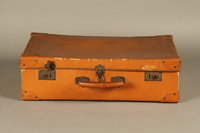
Lightweight valise used by Cila and Baruch Knaster when they immigrated
Object
Lightweight, cardboard valise carried by Cila Hausman Knaster and her husband Baruch Knaster when they, and their oldest daughter, Mirka Knaster, immigrated to the United States in November 1949. Cila and Baruch's families perished during the Holocaust. He was imprisoned in Auschwitz concentration camp, and Mauthausen concentration camp, where he was later liberated. The couple met in a displaced persons camp and married in August 1946. Their daughter, Mirka, was born in May 1947, in a DP camp in Bari, Italy.
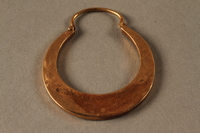
Pair of hinged hoop earrings owned by Cila Knaster
Object
Hinged hoop earrings owned by Cila Hausman Knaster when she, her husband, Baruch Knaster, and their oldest daughter, Mirka Knaster, immigrated to the United States in November 1949. Cila and Baruch's families perished during the Holocaust. He was imprisoned in Auschwitz concentration camp, and Mauthausen concentration camp, where he was later liberated. The couple met in a displaced persons camp and married in August 1946. Their daughter, Mirka, was born in May 1947, in a DP camp in Bari, Italy.
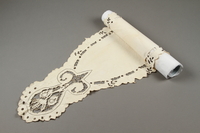
Oval-shaped, embroidered whitework and cutwork table runner owned by Cila Knaster
Object
Hand-embroidered table runner decorated with whitework and cutwork owned by Cila Hausman Knaster when she, her husband, Baruch Knaster, and their oldest daughter, Mirka Knaster, immigrated to the United States in November 1949. Cila and Baruch's families perished during the Holocaust. He was imprisoned in Auschwitz concentration camp, and Mauthausen concentration camp, where he was later liberated. The couple met in a displaced persons camp and married in August 1946. Their daughter, Mirka, was born in May 1947, in a DP camp in Bari, Italy.
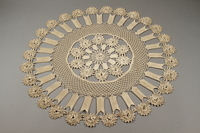
Circular, crocheted, floral and geometric doily owned by Cila Knaster
Object
Crocheted doily decorated with floral and geometric elements owned by Cila Hausman Knaster when she, her husband, Baruch Knaster, and their oldest daughter, Mirka Knaster, immigrated to the United States in November 1949. Cila and Baruch's families perished during the Holocaust. He was imprisoned in Auschwitz concentration camp, and Mauthausen concentration camp, where he was later liberated. The couple met in a displaced persons camp and married in August 1946. Their daughter, Mirka, was born in May 1947, in a DP camp in Bari, Italy.
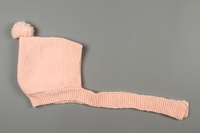
Pink child's sweater and bonnet set knit by Cila Knaster and worn by Mirka Knaster
Object
Matching, pink child's sweater and bonnet made by Cila Hausman Knaster for her daughter, Mirka Knaster, to wear in Bari Transit camp from 1947 to 1949. Cila and her husband, Baruch Knaster's, families perished during the Holocaust. He was imprisoned in Auschwitz concentration camp, and Mauthausen concentration camp, where he was later liberated. The couple met in a displaced persons camp and married in August 1946. Their daughter, Mirka, was born in May 1947, in a DP camp in Bari, The Knaster family immigrated to the United States in November 1949.
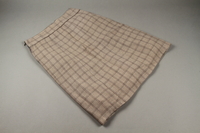
Brown checkered, A-line skirt owned by Cila Knaster
Object
Brown checkered skirt carried by Cila Hausman Knaster and her husband Baruch Knaster when they, and their oldest daughter, Mirka Knaster, immigrated to the United States in November 1949. Cila and Baruch's families perished during the Holocaust. He was imprisoned in Auschwitz concentration camp, and Mauthausen concentration camp, where he was later liberated. The couple met in a displaced persons camp and married in August 1946. Their daughter, Mirka, was born in May 1947, in a DP camp in Bari, Italy.
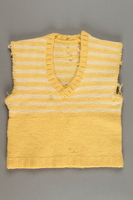
Child's striped yellow vest knit by Cila Knaster and worn by Mirka Knaster
Object
Child's striped yellow vest made by Cila Hausman Knaster for her daughter, Mirka Knaster, to wear in Bari Transit camp from 1947 to 1949. Cila and her husband, Baruch Knaster's, families perished during the Holocaust. He was imprisoned in Auschwitz concentration camp, and Mauthausen concentration camp, where he was later liberated. The couple met in a displaced persons camp and married in August 1946. Their daughter, Mirka, was born in May 1947, in a DP camp in Bari, The Knaster family immigrated to the United States in November 1949.
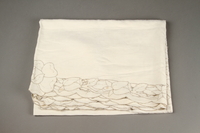
Hand-embroidered floral tablecloth with cutwork elements owned by Cila Knaster
Object
Hand-embroidered tablecloth decorated with floral whitework and cutwork owned by Cila Hausman Knaster when she, her husband Baruch Knaster, and their oldest daughter, Mirka Knaster, immigrated to the United States in November 1949. Cila and Baruch's families perished during the Holocaust. He was imprisoned in Auschwitz concentration camp, and Mauthausen concentration camp, where he was later liberated. The couple met in a displaced persons camp and married in August 1946. Their daughter, Mirka, was born in May 1947, in a DP camp in Bari, Italy.
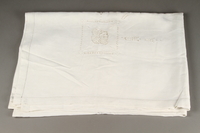
Hand-embroidered whitework and needle lace tablecloth owned by Cila Knaster
Object
Hand-embroidered tablecloth decorated with whitework and needle lace owned by Cila Hausman Knaster when she, her husband Baruch Knaster, and their oldest daughter, Mirka Knaster, immigrated to the United States in November 1949. Cila and Baruch's families perished during the Holocaust. He was imprisoned in Auschwitz concentration camp, and Mauthausen concentration camp, where he was later liberated. The couple met in a displaced persons camp and married in August 1946. Their daughter, Mirka, was born in May 1947, in a DP camp in Bari, Italy.



